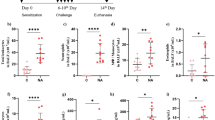Abstract
Background
The unique elastin crosslinks, desmosine and isodesmosine (DID) are significantly elevated in blood, urine, and sputum from patients with COPD, and may decline following treatment of the disease. However, the large degree of variance in this biomarker among COPD patients with similar levels of disease suggests that it has limited prognostic value with regard to the degree of lung disease in a given individual. As an alternative to measuring the total amount of DID, we propose using the ratio of free to peptide-bound DID, which may provide a better indication of overall lung disease.
Methods
To test this hypothesis, the free/bound DID ratio was measured in bronchoalveolar lavage fluid (BALF) from both hamsters with elastase-induced emphysema and controls not given the enzyme, using a combination of liquid chromatography and tandem mass spectroscopy. This ratio was then correlated with airspace enlargement, as measured by the mean percentage of lung surface area at ×100 microscopic magnification.
Results
There was a significant negative correlation between the free/bound DID ratio in BALF and lung surface area. However, there was no correlation between this ratio and total BALF DID, suggesting that free/bound DID is unrelated to the immediate rate of breakdown of elastic fibers, and may instead measure the cumulative effect of elastase injury in the lung.
Conclusions
The free/bound DID ratio may be a useful measure of emphysematous changes in the lung and might also serve as a screening procedure for healthy smokers and other individuals at risk for developing COPD.





Similar content being viewed by others
References
Hogg JC, Timens W (2009) The pathology of chronic obstructive pulmonary disease. Annu Rev Pathol 4:435–459
Barnes PJ (2003) New concepts in chronic obstructive pulmonary disease. Annu Rev Med 54:113–129
Tuder RM, Petrache I (2012) Pathogenesis of chronic obstructive pulmonary disease. J Clin Invest 122:2749–2755
Turino GM, Lin YY, He J et al (2012) Elastin degradation: an effective biomarker in COPD. COPD 9:435–438
Lindberg CA, Engström G, de Verdier MG et al (2012) Total desmosines in plasma and urine correlate with lung function. Eur Respir J 39:839–845
Ma S, Turino GM, Lin YY (2011) Quantitation of desmosine and isodesmosine in urine, plasma, and sputum by LC-MS/MS as biomarkers for elastin degradation. J Chromatogr B 879:1893–1898
Fregonese L, Ferrari F, Fumagalli M et al (2011) Long-term variability of desmosine/isodesmosine as biomarker in alpha-1-antitrypsin deficiency-related COPD. COPD 8:329–333
Luisetti M, Ma S, Iadarola P et al (2008) Desmosine as a biomarker of elastin degradation in COPD: current status and future directions. Eur Respir J 32:1146–1157
Ma S, Lin YY, Turino GM (2007) Measurements of desmosine and isodesmosine by mass spectrometry in COPD. Chest 131:1363–1371
Stauffer D, Aharony A (2001) Introduction to percolation theory, 2nd edn (revised). Taylor and Francis, Philadelphia
Cantor JO, Ma SM, Turino GM (2013) What percolation theory can tell us about COPD. Med Hypotheses 81:152–155
Li B, Daggett V (2002) Molecular basis for the extensibility of elastin. J Muscle Res Cell Motil 23:561–573
Kielty CM, Sherratt MJ, Shuttleworth CA (2002) Elastic fibres. J Cell Sci 115:2817–2828
Bunde A, Kantelhart JW (2005) Diffusion and conduction in percolation systems. In: Heitjans P, Karger J (eds) Diffusion in condensed matter. Springer, Berlin, pp 895–914
Redner S (2009) Fractal and multifractal scaling of electrical conduction in random resistor networks. In: Meyers PA (ed) Encyclopedia of complexity and systems science. Springer, Berlin, pp 3737–3754
Sander LM, Warren CP, Sokolov IM et al (2002) Percolation on heterogeneous networks as a model for epidemics. Math Biosci 180:293–305
Sahimi M (2009) Percolation phase transition. In: Meyers PA (ed) Encyclopedia of complexity and systems science. Springer, Berlin, pp 6538–6545
Suki B, Bates JH (2011) Lung tissue mechanics as an emergent phenomenon. J Appl Physiol 110:1111–1118
Bates JH, Davis GS, Majumdar A et al (2007) Linking parenchymal disease progression to changes in lung mechanical function by percolation. Am J Respir Crit Care Med 176:617–623
Murphy KD, Hunt GW, Almond DP (2006) Evidence of emergent scaling in mechanical systems. Philos Mag 86:3325–3338
Jesudason R, Black L, Majumdar A et al (2007) Differential effects of static and cyclic stretching during elastase digestion on the mechanical properties of extracellular matrices. J Appl Physiol 103:803–811
Doyle TJ, Pinto-Plata V, Morse D et al (2012) The expanding role of biomarkers in the assessment of smoking-related parenchymal lung diseases. Chest 142:1027–1034
Rosenberg SR, Kalhan R (2012) Biomarkers in chronic obstructive pulmonary disease. Transl Res 159:228–237
Conflict of interest
None of the authors has a conflict of interest with regard to the material included in this paper.
Author information
Authors and Affiliations
Corresponding author
Rights and permissions
About this article
Cite this article
Liu, X., Ma, S., Liu, S. et al. The Ratio of Free to Bound Desmosine and Isodesmosine May Reflect Emphysematous Changes in COPD. Lung 193, 329–334 (2015). https://doi.org/10.1007/s00408-015-9712-z
Received:
Accepted:
Published:
Issue Date:
DOI: https://doi.org/10.1007/s00408-015-9712-z




